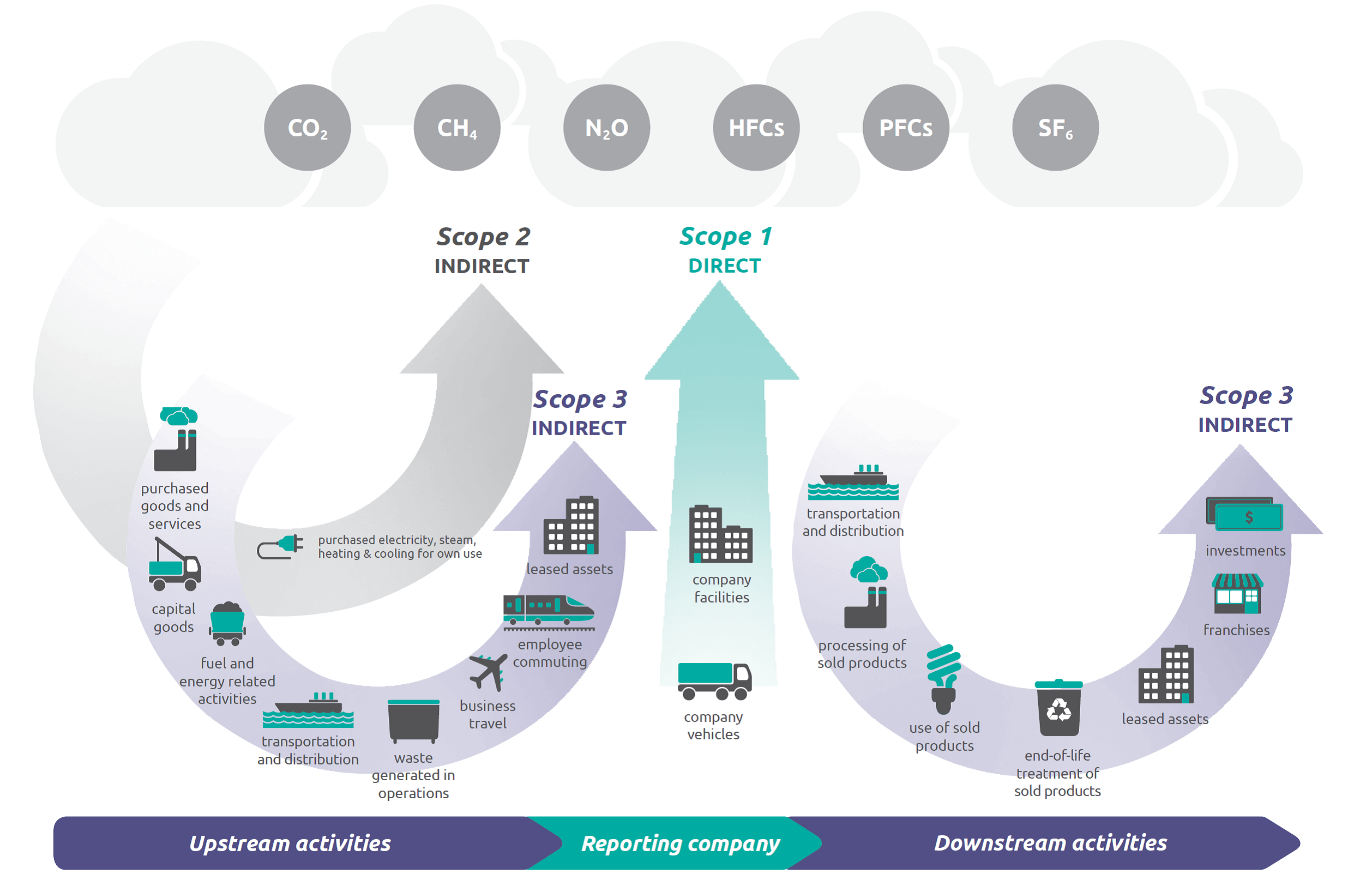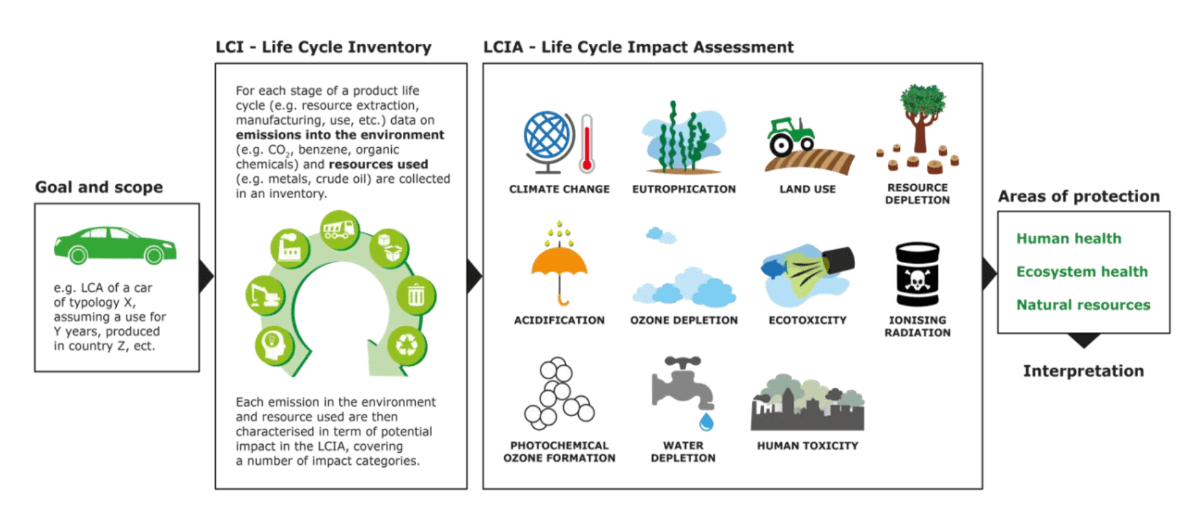
26 January 2024
Understanding the Difference Between LCA and Carbon Footprint
In today’s world, where environmental responsibility is key, it’s vital to understand two core concepts: Life Cycle Assessment (LCA) and Carbon Footprint.
In this article, we’ll dive into these terms. It reveals their details, highlights their differences, and emphasizes their importance in understanding environmental impact assessment and sustainability metrics.
What is the Carbon Footprint?
A carbon footprint is a key metric in sustainability reporting that quantifies the total greenhouse gases (GHGs) emitted by an entity, encompassing not just CO2, but also gasses like methane and nitrous oxide.
It’s essential for sustainable business practices, calculated across three scopes: direct emissions (Scope 1), indirect energy emissions (Scope 2), and other indirect emissions (Scope 3). Understanding these elements is essential in the journey towards eco-friendly operations and green business initiatives. Learn more about greenhouse gas reporting and its implications in our detailed guide.
How to calculate carbon footprint of product
The calculation of the carbon footprint for a specific product includes the greenhouse gas emissions produced during a product’s life cycle, from extraction to waste disposal. A product carbon footprint (PCF) is the calculation of all of the greenhouse gas (GHG) emissions generated in the supply chain and or life cycle of a specific product. Measured in Carbon dioxide equivalents (CO2e).
When calculating a product carbon footprint, it’s essential to define their scope or boundary. Two different approaches are:
- Cradle-to-Gate:
This method is typically applied to products designed for business-to-business (B2B) transactions. It calculates the total greenhouse gas emissions starting from the extraction of raw materials and continues up to the point of manufacturing, ending at the factory’s gate. - Cradle-to-Grave:
Commonly used for products intended for business-to-consumer (B2C) interactions, this approach encompasses a more comprehensive assessment. It tracks the total greenhouse gas emissions from the initial extraction of raw materials, through the manufacturing process, distribution, usage, and finally includes the end-of-life disposal of the product.

Life Cycle Assessment Explained
Often referred to as LCA, companies employ Life Cycle Assessment (LCA) as a structured methodology. It allows them to evaluate the environmental impacts of a product, process, or service throughout its entire life cycle, from cradle-to-grave. This encompasses all stages, starting from the extraction of raw materials to manufacturing, distribution, utilization, and eventual end-of-life.
Leading international standards, such as ISO 14040 and ISO 14044, ensure consistent and transparent LCA studies, making it easier to compare and communicate results. These standards are frequently used in Corporate Social Responsibility (CSR) reporting to communicate environmental impact and sustainability activities to stakeholders.

The four key phases of LCA
- Objective and Scope of the Study:
In this initial phase, the purpose and scope of the LCA are defined. Additionally, the boundaries of the system under examination are established. - Data Inventory (Life Cycle Inventory):
In this phase, data is collected and quantified for system inputs and outputs, including energy, materials, water, and emissions - Life Cycle Impact Assessment (LCIA):
This phase assesses the environmental impacts of the system using various impact categories. - Impact Interpretation:
The final phase interprets the LCA results and draws conclusions about the environmental performance of the system.
For a deeper understanding of how LCA integrates with other frameworks like Product Environmental Footprint (PEF) and Product Environmental Footprint Category Rules (PEFCR), consider our detailed exploration in this article.
The Difference Between LCA and Carbon Footprint
When it comes to understanding and managing environmental impacts, distinguishing between Life Cycle Assessment (LCA) and carbon footprint is essential.
Beyond Carbon Emissions: A Deeper Dive with LCA
LCA is more than just a measurement tool, it represents a strategic approach to environmental management. Covering a wide spectrum of environmental issues, offering insights that extend beyond the conventional boundaries of carbon footprint analysis. This comprehensive view ensures that LCA captures a broad range of environmental impacts, making it a more inclusive and informative approach to understanding a product’s environmental footprint.
No Impact Transfer: The Comprehensive Nature of LCA
A significant advantage of Life Cycle Assessment is its meticulous focus on the entire life cycle of products ensuring there is no transfer of impact from one stage to the other. This detailed assessment allows businesses to provide their clients with specific insights into the environmental impact of their purchases. This level of detail is especially beneficial for companies committed to transparency and responsible environmental practices.
Comparative Analysis: LCA vs Carbon Footprint
One of the strengths of LCA analysis lies in its international standards-driven approach, ensuring that the results of a specific LCA analysis are readily comparable, making it easier to distinguish between LCA vs Carbon Footprint.
Leveraging LCA for Eco-Design
Furthermore, LCA doesn’t stop at providing comparative data alone. It also serves as a valuable resource for shaping eco-design strategies. This goes beyond assessment and extends to strategic implementation, allowing businesses to actively improve their environmental practices.
LCAs can inform eco-design strategies, enabling companies to adapt and redefine their products. Such proactive measures actively contribute to reducing environmental impact and pave the way for more sustainable product development. By experimenting with various parameters, you can directly observe the positive or negative environmental impact of your product.
Elevating Stakeholder Communication: The Clarity of LCA Over Carbon Footprint
As the corporate world strides towards more accountable environmental reporting, the transition from carbon footprint to Life Cycle Assessment (LCA) becomes increasingly significant.
The carbon footprint, while foundational, is beginning to show its limitations, particularly when it comes to meeting the evolving inquiries from stakeholders who now demand more than just a snapshot of annual emissions.
LCA emerges as a robust, future-proof method that not only satisfies but exceeds these stakeholder expectations by offering a transparent and qualitative narrative of a product’s environmental journey. It allows businesses to not just report on, but actively manage and communicate the continuous evolution of their product portfolio.
This transition is not just about adhering to the present-day standards but also about establishing new precedents for in-depth, proactive stakeholder engagement, marking a shift in how businesses address the critical differences between LCA and carbon footprint.
Mastering the Difference Between LCA and Carbon Footprint in Sustainability Management
Life Cycle Assessment (LCA) over traditional carbon footprint analysis marks a significant leap. This decision doesn’t just widen the lens of environmental analysis. It arms your business with the actionable insights essential for driving real, sustainable change.
LCA transcends mere data collection, offering a dynamic framework for businesses to not only track but actively enhance their environmental strategies. By embedding LCA into their core operations, companies can navigate sustainability challenges with greater precision, aligning themselves with both current and future sustainability goals. This alignment is not just about compliance. It’s about demonstrating a deep-rooted commitment to environmental responsibility, a commitment that resonates powerfully with eco-conscious consumers and stakeholders.
In today’s rapidly evolving sustainability landscape, the difference between LCA and carbon footprint becomes clear. While carbon footprint analysis provides valuable insights for stakeholder reporting. It often stops short of the in-depth analysis required for tangible product enhancements.
LCA, conversely, emerges as a proactive tool, enabling businesses to refine and future-proof their product portfolios. This ensures they are equipped to meet and exceed stakeholder expectations in both efficiency and quality of environmental communication.
Empowering Sustainability with Pilario’s Innovative SaaS Solution
Change your approach to sustainability with Pilario. Our SaaS platform simplifies Life Cycle Assessments (LCAs), offering straightforward solutions that adapt to various roles within any organization. Whether you’re in management, a sustainability specialist, a marketer, or somewhere in between, Pilario is your one-stop shop for sustainability.
Clients like AB InbevHeineken and Ball have already elevated their sustainability reporting, LCA analysis and decision-making with our intuitive software. Now, it’s your turn. Choose from predefined LCA models tailored to industries ranging from beverages to packaging, input your data, and start reducing your environmental footprint with precision and ease.
Step into a future where sustainable management is not only possible but simple for everyone. With Pilario, you’re not just adopting a software; you’re embracing a journey towards a more sustainable business model. Begin your journey with Pilario today—where innovation meets environmental stewardship.
Discover how Pilario can elevate your sustainability practices. Connect with us for a demo, follow our updates on Linkedin, or explore our solutions on our website.